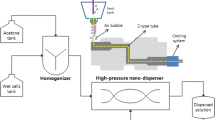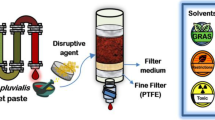Abstract
A green, downstream process using common vegetable oils was used for the direct extraction of astaxanthin from Haematococcus. The process consists of a single integrated unit to extract astaxanthin with subsequent separation of the astaxanthin-containing oil extract. Without a cell harvest process step, the culture broth was directly mixed with the vegetable oils; the astaxanthin inside the cell was extracted into the vegetable oil phase by hydrophobic interactions, with recovery yields of 88% and above. The oil extracts were simply separated from the culture medium containing cell debris by gravity settling only.


Similar content being viewed by others
References
Britton G, Liaaen-Jensen S, Pfander H (2004) Carotenoids handbook. Birkhäuser Verlag, Basel, Switzerland
Fábregas J, Domínguez A, Maseda A, Otero A (2003) Interactions between irradiance and nutrient availability during astaxanthin accumulation and degradation in Haematococcus pluvialis. Appl Microbiol Biotechnol 61:545–551
Guerin M, Huntley ME, Olaizola M (2003) Haematococcus astaxanthin; applications for human health and nutrition. Trends Biotechnol 21:210–216
Harker M, Tsavalos AJ, Young AJ (1996) Factors responsible for astaxanthin formation in the chlorophyte Haematococcus pluvialis. Bioresour Technol 55:207–214
Hejazi MA, Wijffels RH (2004) Milking of microalgae. Trends Biotechnol 22:189–194
Hussein G, Sankawa U, Goto H, Matsumoto K, Watanabe H (2006) Astaxanthin, a carotenoid with potential in human health and nutrition. J Nat Prod 69:443–449
Kang CD, Lee JS, Park TH, Sim SJ (2005) Comparison of heterotrophic and photoautotrophic induction on astaxanthin production by Haematococcus pluvialis. Appl Microbiol Biotechnol 68:237–241
Kang CD, Lee JS, Park TH, Sim SJ (2007) Complementary limiting factors of astaxanthin synthesis during photoautotrophic induction of Haematococcus pluvialis: C/N ratio and light intensity. Appl Microbiol Biotechnol 74:987–994
Kobayashi M, Sakamoto Y (1999) Singlet oxygen quenching ability of astaxanthin esters from the green alga Haematococcus pluvialis. Biotechnol Lett 21:265–269
Kobayashi M, Kakizono T, Nagai S (1993) Enhanced carotenoids biosynthesis by oxidative stress in acetate-induced cyst cells of a green unicellular alga, Haematococcus pluvialis. Appl Environ Microbiol 59:867–873
Kobayashi M, Kurimura Y, Tsuji Y (1997a) Light independent, astaxanthin production by the green microalga Haematococcus pluvialis under salt stress. Biotechnol Lett 19:507–509
Kobayashi M, Kurimura Y, Sakamoto Y, Tsuji Y (1997b) Selective extraction of astaxanthin and chlorophyll from the green alga Haematococcus pluvialis. Biotechnol Tech 11:657–660
Lorenz RT, Cysewski GR (2000) Commercial potential for Haematococcus microalgae as a natural source of astaxanthin. Trends Biotechnol 18:160–167
Machmudah S, Shotipruk A, Goto M, Sasaki M, Hirose T (2006) Extraction of astaxanthin from Haematococcus pluvialis using supercritical CO2 and ethanol as entrainer. Ind Eng Chem Res 45:3652–3657
Margalith PZ (1999) Production of ketocarotenoids by microalgae. Appl Microbiol Biotechnol 51:431–438
Mendes-Pinto MM, Raposo MFJ, Bowenl J, Young AJ, Morais R (2001) Evaluation of different cell disruption processes on encysted cells of Haematococcus pluvialis: effects on astaxanthin recovery and implications for bio-availability. J Appl Phycol 13:19–24
Montsant A, Zarka A, Boussiba S (2001) Presence of a nonhydrolyzable biopolymer in the cell wall of vegetative cells and astaxanthin-rich cysts of Haematococcus pluvialis (Chlorophyceae). Mar Biotechnol 3:515–521
Sarada R, Vidhyavathi R, Usha D, Ravishankar GA (2006) An efficient method for extraction of astaxanthin from green alga Haematococcus pluvialis. J Agric Food Chem 54:7585–7588
Wang B, Zarka A (2003) Astaxanthin accumulation in Haematococcus pluvialis (Chlorophyceae) as an active protective process under high irradiance. J Phycol 39:1116–1124
Wang S-B, Hu Q, Sommerfeld M, Chen F (2004) Cell wall proteomics of the green alga Haematococcus pluvialis (Chlorophyceae). Proteomics 4:692–708
Acknowledgement
This research was supported by a grant (DG2-201) from the Carbon Dioxide Reduction & Sequestration Research Center, one of the 21st Century Frontier Programs funded by the Ministry of Science and Technology of the Korean government.
Author information
Authors and Affiliations
Corresponding author
Rights and permissions
About this article
Cite this article
Kang, C.D., Sim, S.J. Direct extraction of astaxanthin from Haematococcus culture using vegetable oils. Biotechnol Lett 30, 441–444 (2008). https://doi.org/10.1007/s10529-007-9578-0
Received:
Revised:
Accepted:
Published:
Issue Date:
DOI: https://doi.org/10.1007/s10529-007-9578-0




